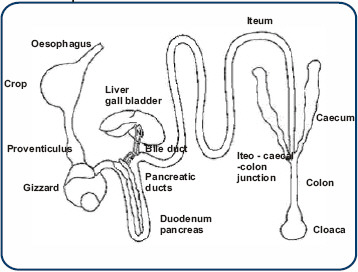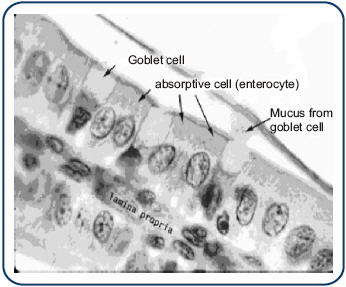



Maintaining Gut Integrity
By Dr. Harish V. Dharne, head of Avitech’s Business Promotion and Knowledge Resource Centre. Nutrition and gut health are closely related in commercial poultry production.Diet formulation and feed management can have a marked effect on gut health greatly influencing nutrient utilization and growth of the animal. Gut health problems arise due to improper nutrition and an unhygienic environment especially during the early stages of chick development.

For cost effective and sustainable commercial operations there is need to:
- Maintain natural gut health through proper nutrition and a clean environment, and
- Effective treatment of an existing gut disorder.
Function and Structure of Gastro Intestinal Tract
To improve gut health, a clear understanding of the structure and functionality of the gut is important. The fowl's digestive system breaks down ingested food to basic components by mechanical and chemical means. These basic components are then absorbed through intestinal cells and utilized throughout the body.
The digestive system begins at the mouth and ends at the cloaca. Intervening organs/parts include oesophagus, crop, proventriculus, gizzard, duodenum, small intestine, paired caeca and large intestine. Other organs vital to digestion are the liver and the pancreas.

With few exceptions (presence of crop, gizzard, proventriculus, a short colon, the cloaca), the GIT anatomy and physiology of the birds is similar to mammals. Because of adaptation for flight, the GIT size, relative to body weight is small in birds. However, this is compensated by the higher vascularity, higher gastric secretion rate, increased transit time, and acidity of the GIT compared to mammals. Birds also have high numbers of intestinal villi and high epithelial turnover rate (48 to 96 h), and rapid inflammatory response (less than 12 hours, as compared to 3-4 days in mammals), which makes them more susceptible to disturbances in absorptive capacity than mammals.
| Transit time and pH in poultry GIT | ||
| GIT Segment |
Transit Time(Min) |
pH |
|---|---|---|
| Crop | 50 | 5.5 |
| Proventriculus / gizzard | 90 | 2.5-3.5 |
| Duodenum | 5-8 | 5-6 |
| Jejunum | 20-30 | 6.5-7.0 |
| Ileum | 50-70 | 7.0-7.5 |
| Colon | 25 | 8.0 |
| Source: R.Gauthier(2002) | ||
Intestinal integrity
Intestinal integrity may be described as the intactness of the intestine in maintaining its structure and function or simply an unimpaired and sound intestine.
Maintaining sound gut (Gastro inestinal tract)
A sound gut ensures:
- Proper digestion and absorption of valuable feed nutrients
- Less wastage of nutrients
- Minimum foul odor
- Provides resistance against entero-pathogens
- Checks mortality and morbidity losses
- Optimizes feed conversion ratio
Natural Physical Barriers that Help to Maintain Intestinal Integrity
Physical barriers protect against the entry of foreign materials and organisms into the bloodstream and access to other viscera thus helping intestinal integrity. On occasion due to improper nutrition or an unhygienic environment, when the load of foreign invaders increase these barriers are breached.
- Mucus (a protective1. Mucus: material secreted by intestinal cells) is a barrier to bacterial and fungal invasion. It is broken by some enzymes (eg. mucinolytic, urease). Poultry feeds with under cooked soy meal may contain urease.
- Gut epithelial cells (enterocytes): These cells form a semi-permeable surface that selectively allows passage of fluid, electrolytes, and dissolved nutrients. Every epithelial cell in the digestive tract is part of a continuous physical barrier. When organisms and toxic agents damage epithelial cells, the integrity of this protective barrier is broken.
- Fluid secretion: fluid having large amounts of water mixed with electrolytes. The fluid in the upper small intestine is protective and keeps bacteria in suspension and washes them downstream.
- Vascular supply: supply under the gut epithelial layer serves to rapidly dilute and carry away any agents or chemicals (endogenous or exogenous) that may breach the mucosal barrier.

Factors Influencing Gut Integrity
- Physical barriers: Intestinal integrity is compromised when the mucus layer is degraded; epithelial cells are effaced or destroyed, the vascular supply is interrupted, or the immune system is compromised. Viruses, bacteria, fungi, parasites, and toxins can damage this.
- Stress factors: Gut environment is also altered by several stress factors to the birds like handling, transportation, overcrowding, abrupt changes in environment etc.
- Feed toxins and toxicants: Feed toxins and toxicants can also affect the gut integrity.
- Dietary factors: Nutritional deficiency due to imbalance in ration formulation, grain engorgement, microbial load in feed etc. affect gut health. The nature of the diet, for example presence of non-starch polysaccharide (NSP) especially soluble fractions in the diet provide substrate for the growth of undesirable bacteria and accumulation of fermentation products affecting the gut severely. Insoluble NSP is a major problem leading to soiling of litter.
- Health status: Diseases like coccidiosis and fowl plague are found to affect the gut integrity severely. Infections, injuries etc. also affect gut health.
- Gut micro flora: The rich bacterial community that make up the gut micro flora play an important role for the host through changes in the morphology of gut, nutrition, pathogenesis of enteric diseases, immune response and alterations in colonization resistance. The shift in composition of this microflora results in production and efficiency losses often in the absence of any clinical signs. Useful microbes (commensal bacteria) in gut play a positive role in controlling the gut flora and stimulate the development of the gut wall. Hence, microbial balance of gut is utmost important in maintaining gut integrity.
- Beak deformity: Beak deformity preventing proper feed consumption may impair gut health.
Early Chick Nutrition and Gut Health
Good start is an important factor in maximizing profits from broiler operations. Early nutrition mainly in the first 7 days of life for broilers may program the birds' systems and set a pattern for growth and productivity. A large percentage of early growth (2 to 5 times the growth rate of other tissues) occurs in the digestive tract and those organs involved in digestion. If digestive growth is retarded during this time period, overall growth rate may be compromised. Further newly hatched chicks are more prone to gut infections as its natural defense is yet to be strengthened. So proper care should be taken during this time period.
Feeding of chicks:
It is now well accepted that early access to nutrients post hatch has a major impact on the immediate and long-term development of the chick. Research on the early life of chickens has led to the conclusion that the immediate post hatch period is critical for the development of all systems in chicks including the immune system. The development of bursa and spleen is responsive to environmental stress at an early age in chicks. Delayed access to nutrients post hatch reduces the relative weight of bursa and spleen. The passage of feed that is not sterile, through the gastro-intestinal tract exposes the bursa to a variety of antigens. So the earlier the chicks are fed post hatch, the sooner will the proliferation stem cell meet environmental antigens. This clearly suggests that early nutrition is important in laying a strong foundation for the health status of birds in a situation where little or no antibiotics are allowed in their feed. Suitable feed additives should be added in the starter diet as precautionary measure that will ensure better health and productivity.
Role of Dietary Factors in Improving Intestinal Integrity
- Quality feed ingredients: Supplementation of quality feed ingredients helps in maintaining natural gut health.
- Processed feed: Many incriminating factors of feed are destroyed due to processing. Extrusion is effective in reducing microbial contamination in feedstuffs and in Salmonella control.
- Pelleted feed: Pelleting provides scope for utilization of high fibre feed resources. Use of steam- pelleted feed seems to be of value in maintaining gut health.
- Feed additives: Commercial poultry production during the last 50 years has benefited from pharmaceutical and biological products that enabled flock size to increase, genetic potential and improved nutritional formulations to be realized, and overall production to increase. Food animal agriculture is providing wholesome poultry meat protein for consumption in the human diet at unprecedented levels. Some feed additives that promote the gut health either directly or by preventing the enteric pathogens are discussed below
- Anticoccidials and Ionophores Coccidiosis, a managemental disease, causes devastating losses to the poultry industry. It is an infection of the intestinal tract caused by a single cell parasite. The disease is characterised by an invasion and damage of the intestinal wall by the parasite resulting in severe haemorrhage and mortality. For this reason, it is essentially added in most poultry rearing situations during the rearing period to prevent illness and control infections. When used in a structured and monitored programme, anticoccidial agents are very effective and permit the optimum performance of the animal without compromising health status. No new anticoccidial agent has come onto the market since the 1980s, which is in part a reflection of the success that the ionophores have brought to the control of the disease.
- Probiotics (Direct-fed microbials) “A probiotic is defined as a live microbial feed supplement which beneficially affects the host animal by improving its intestinal microbial balance.” Gut flora may be disturbed under several circumstances including the use of antibiotics or other drugs, excess stress, disease, exposure to toxic substances, which allows harmful competitors to thrive in the gut. Probiotics prevent such harmful bacteria (enteric pathogens) from growing in the gut and thus minimize the disturbances caused by them, and also maintain host favourable bacteria. Thus Probiotics balance gut microflora. Probiotics are also used as an alternative to antibiotics. However, probiotics are not a substitute for antibiotics in birds with serious infections but are useful in restoring the normal bacterial population that was otherwise altered due to administration of antibiotics. If the conditions that originally caused damage to the natural gut flora persist, the benefits obtained from probiotic supplements will be short lived.
- Prebiotics Prebiotics are non-digestible food ingredients (readily fermentable sugars), that beneficially affect the host by selectively stimulating the growth and/or activity of one or a limited number of bacteria in the colon, and thus improve host health. Most potential prebiotics are carbohydrates (such as oligosaccharides). Prebiotic oligosaccharides may be added to processed foods. Some prebiotics that are used in this manner against pathogens are fructo-oligo-saccharides (FOS), xylo-oligo-saccharides (XOS), mannan-oligo-saccharides (MOS) and galacto-oligo- saccharides.
- Synbiotics Although use of probiotic formulations may well help in achieving these benefits, it is also possible to increase and maintain a healthy bacterial gut flora by increasing the amounts of prebiotics in the diet such as inulin (naturally occurring oligosaccharides), raw oats, and unrefined wheat. As probiotics are mainly active in the small intestine and prebiotics are only effective in the large intestine, the combination of the two gives a synergistic effect. Appropriate combinations of pre- and probiotics are termed as synbiotics.
- Acidifiers/Organic acids Acidifiers/Organic acids include short chain fatty acids, volatile fatty acids and weak carboxylic acids that are only partly disassociated. They may play a role in maintaining gut integrity in the way that they reduce the colonization of pathogens (like Salmonellaand E.coli) in intestinal wall by lowering the intestinal pH below 6.0, and promoting the normal microflora growth. This condition also increases the efficiency of all digestive enzymes. Daily application of short chain fatty acids such as Butyric acids increases epithelial cell proliferation, quick repairing of the intestine, increased villous height and in turn increased absorptive capacity. Alone or in combination, these are beneficial to the animal's health.
- Enzymes: Extra enzymes can add to the animals' own digestive capacity. Feeding high viscosity cereal grains to broilers result in larger microbial populations in the ileum. Viscosity reduces the passage rate of the feed leading to overall reductions in consumption and decreased performance, sticky droppings and dirty eggs. A viscous environment slows down digestion processes, and encapsulates nutrients, making them inaccessible to digestive enzymes. Viscous gels are formed in the digesta by the soluble NSP, which are not digested by the animal's own enzymes. Thickening of unstirred water layer due to gel formation also inhibit absorption. Thus non-starch polysaccharides form a major target substrate for feed enzymes. The addition of enzymes to address NSP viscosity can improve gut health, feed efficiency, improve manure quality and facilitate the use of lower cost feed ingredients.
- Toxin binders Toxin binders are used through feed to bind or adsorb deleterious substances such as mold and fungi-borne mycotoxins. These are the invisible thieves or a hidden danger in animal feed, to animal health and production. They may also accumulate in animal products and contaminate the human food chain.
- Antibiotic growth promoters With the intensification of livestock farming the use of antibiotics for growth promotion has become popular. Antibiotic growth promoters are feed additives that are administered at a low, sub therapeutic dose to suppress sensitive populations of bacteria in the gut and improve growth and performance of bird. The reason is that a reduction in gastrointestinal infections would result in the subsequent increase in muscle weight. It has been estimated that as much as 6per centof the net energy in the diet could be lost due to microbial fermentation in the intestine (Jensen, 1998) and stimulation of energy-consuming immune responses. If the microbial population could be better controlled, it is possible that the lost energy could be diverted to growth. Whatever the mechanism of action, the result of the use of growth promoters is an improvement in daily growth rates between 1 and 10per cent resulting in meat of a better quality, with less fat and increased protein content
Limitations:
- An overuse of any antibiotic over a period of time may lead to the local bacterial populations becoming resistant to the antibiotic.
- Antibiotic residues in the products may affect humans. Essentially, there are two main ways in which we can reduce our dependence on antibiotic use in animals. An obvious choice is the development of alternatives to antibiotics that work via similar mechanisms, promoting growth whilst enhancing the efficiency of feed conversion. A more difficult route would be to improve animal health.
Conclusion:
In summary the GIT is continuously exposed to multiple foreign materials and insults. Regardless of the level of hygiene and biosecurity imposed at production level, poultry will be exposed to multiple infections and toxic agents through the feed and environment. Aerobic and anaerobic bacteria, toxin-producing fungi, and protozoan parasites (coccidian) are unlikely to be eliminated from poultry production units.
Because of the potential development of antibiotic resistant human pathogenic bacteria, the use of antibiotics, have come under increasing scrutiny. Hence, today's intensive animal agriculture industry must adapt to producing animals in a world without antibiotic growth promoters. There are several alternatives to antibiotics as discussed above to manage gut health. Although no single alternative may be as effective as antibiotics, a combination of strategies and feed additives can be used to achieve good gut health and growth performance. There is need of proper care in selecting a feed additive or a combination of feed additives to be added in the diet to promote optimum digestion conditions (function) as well as health (physic/structure) of the intestine. Nutrients are intended, after all, to be taken up and used by the host animal, rather than by the resident bacteria.








